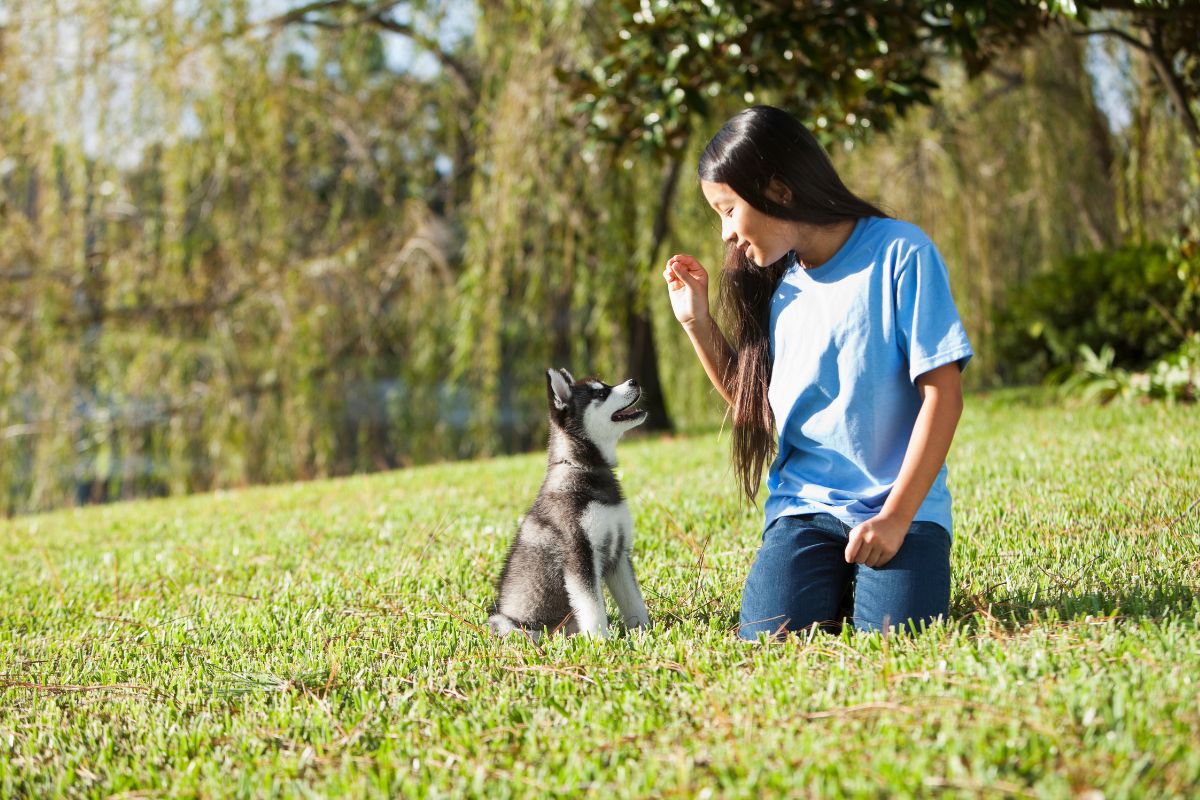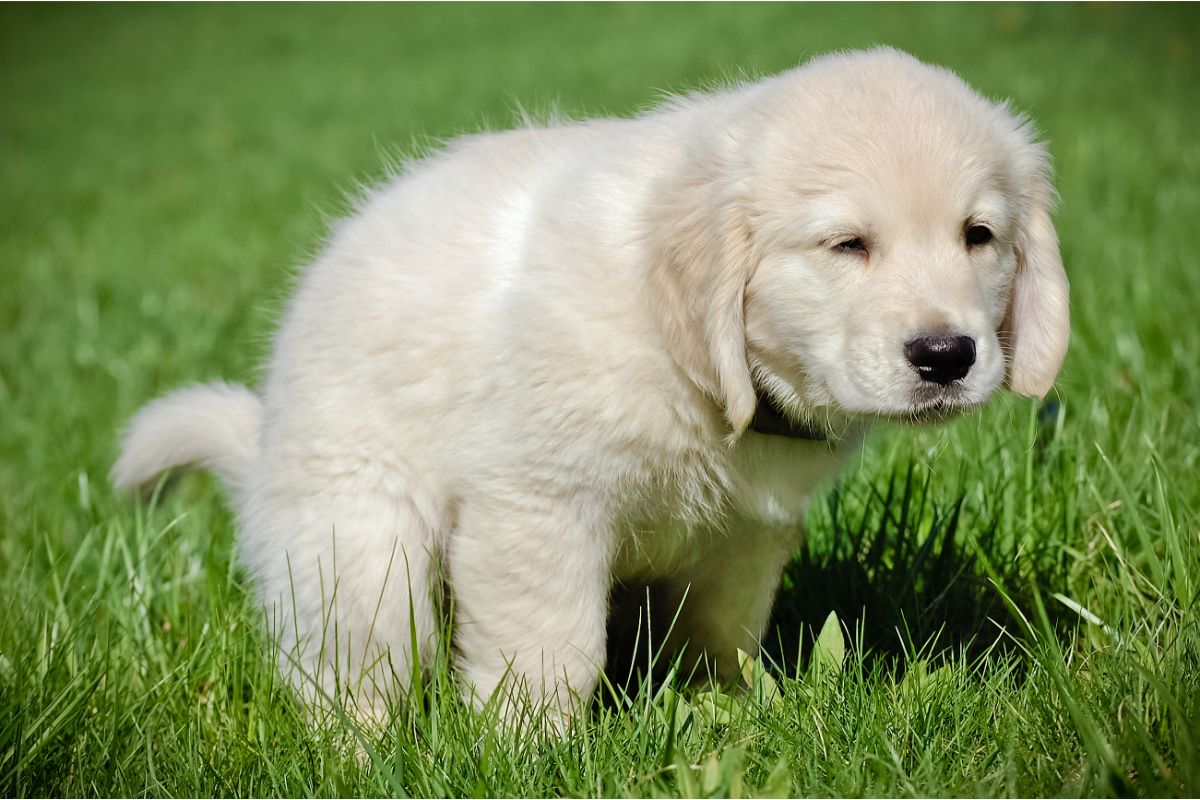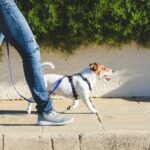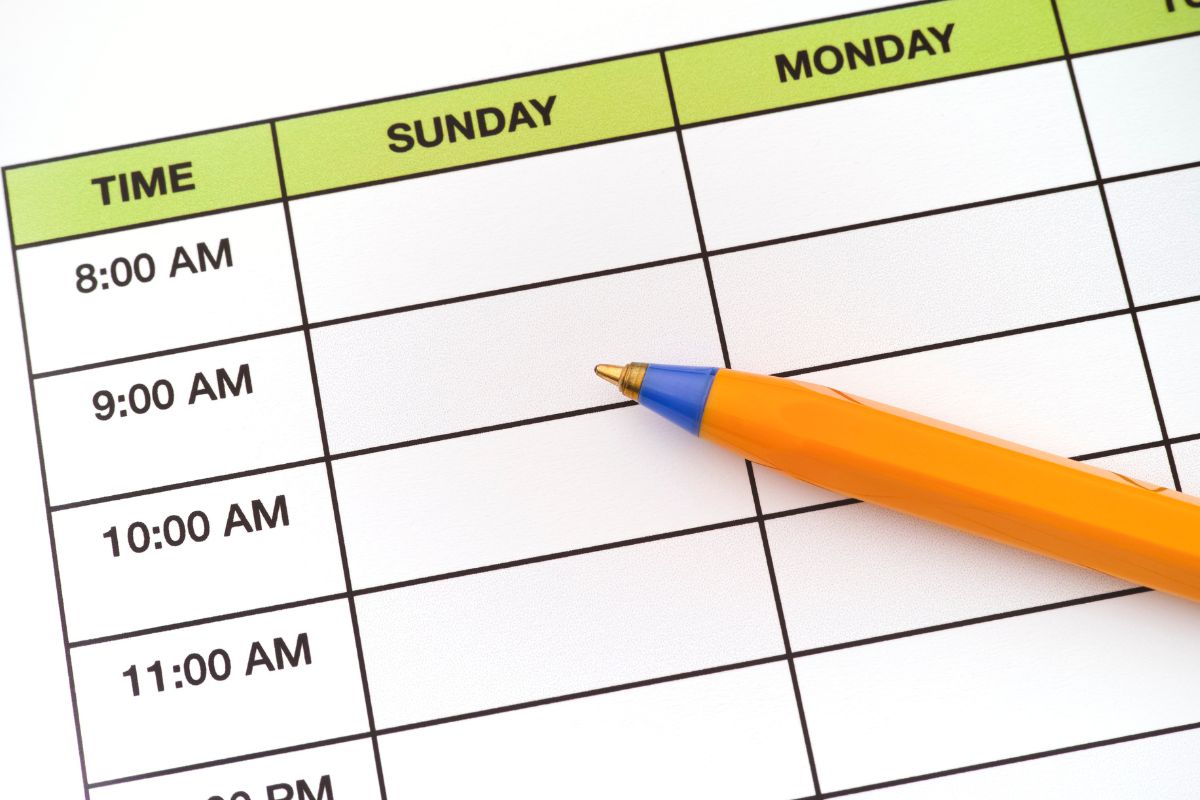Have you got a new puppy? Are you struggling to walk them or you’re unsure how to train them to walk properly on a leash? We can help you!
Teaching your puppy to walk on a leash is one of the best ways to ensure that your dog gets used to being on a leash, reducing the risk of leash reactivity, and preventing your dog from pulling and lunging while on a leash.
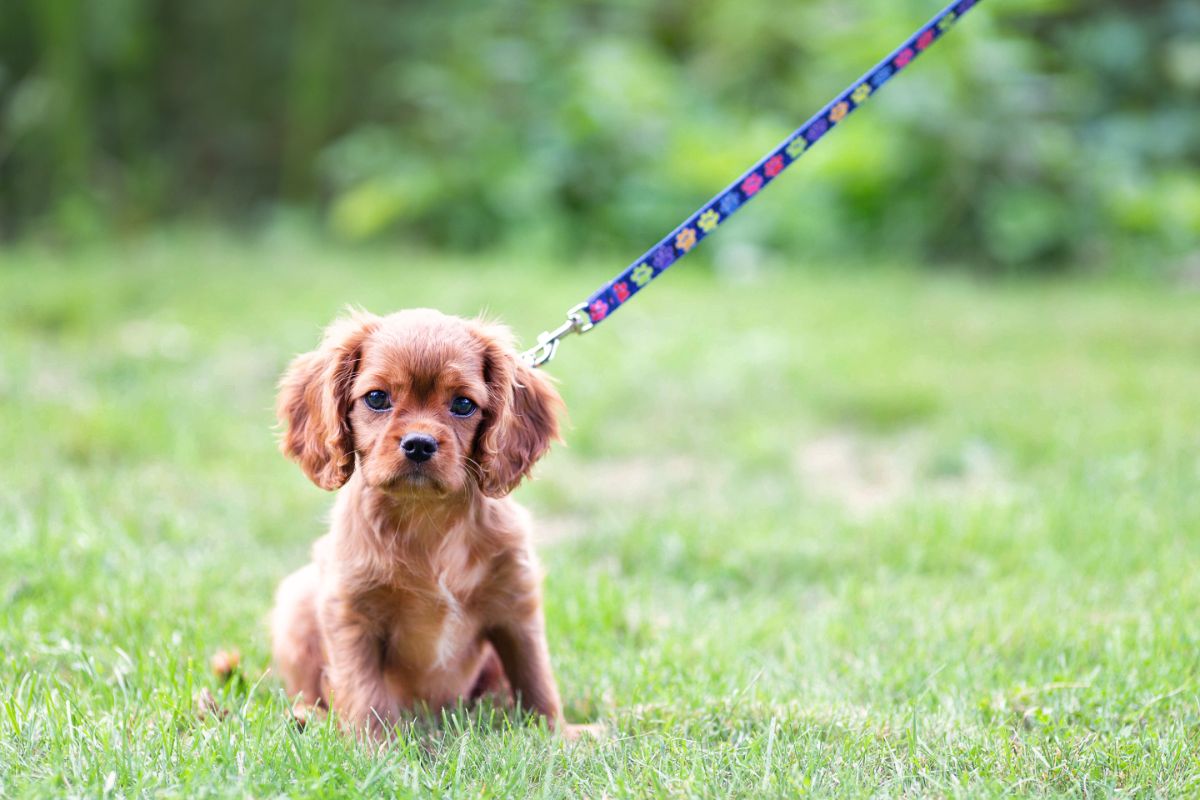
If you want stress free walks, and want to make sure that your puppy becomes used to walking on a leash, then we have some great tips for you.
How To Teach Your Puppy To Walk On A Leash
To ensure that your puppy can walk properly on a leash, you have to introduce the leash to them first, and it’s a good idea to practice before you go out into the big wide world.
Get Them Used To A Leash & Harness
The first step is to introduce the leash and harness to your puppy. You have likely already gotten them used to a collar, so you know that they can become comfortable with a leash as long as they are exposed to it regularly.
Before you try and take your puppy for a walk, then you will want to practice exposing them to the leash.
To do so, you will have to get your puppy all geared up. If you plan on using a harness, then place the harness on them, and clip on the leash.
For smaller or younger puppies, it is best to measure them for a harness before purchasing one. The harness should be snugly fit, and easy to get on or off. Choose a harness that can be stepped into, and doesn’t restrict their chest.
Harnesses with straps across the chest can reduce shoulder movement and cause joint issues, so ensure you pick one that is supportive, padded, and will not restrict your puppy’s growing bones and joints.
Once the harness is on, make sure that it is clipped in and secure. You don’t want it too loose that they could slip out, and not too tight that it is uncomfortable for them.
Clip on a leash that is shorter, and easier to control a busy, excitable puppy.
At first, it is a good idea to let them walk around in the harness in your home, so that they can get used to the feel of the harness. Let the leash drag around behind them.
Now, your puppy may not like the feeling of the harness, and may try to bite on the leash. Be patient, and distract them from biting with positive reinforcement.
The next step is to hold the leash yourself, and guide the puppy around your home.
This can help build a positive relationship between you and the puppy, and help them learn that it is a good thing to be on a leash with you and under your control.
You can also walk them in your backyard or around your home at first. Let them sniff, explore, and guide them around with the lead so that they understand what it means to be on a lead, and that you are the leader.
Teach Your Puppy To Heel
At home and in your backyard, you can also begin implementing the ‘heel’ command. The heel command is when your dog is walking beside you or at your heels.
Teaching them this command can help you teach your dog to listen to your command when needed, and walk by your side in a controlled manner.
Choose a side that you would like your puppy to sit or stand by when you say ‘heel’ and keep this consistent throughout the training.
When your puppy listens to you, and changes their position so that they are by you, reward them with treats and use positive reinforcement.
It is best to practice heel at home so that it is easier for your puppy to focus on you, and not be distracted by other dogs, animals, or scents.
To teach a ‘heel’ position, you will need to have your puppy beside you on the chosen side. If your puppy walks beside you, on the correct side, keep a treat in hand and position it near their nose.
Then, walk forward a few steps and say ‘heel’. When your puppy follows, say ‘yes’ or ‘good’ and reward them with the treat.
Keep practicing this, taking more steps at a time, and if your puppy starts to stray away from the desired position, then reset them and ensure that they know where the right position is.
Repeat the process over and over until it starts to stick.
Once your puppy can successfully heel around the home, try doing this outside where there are a few more distractions.
Don’t do it in a public area just yet, your back yard or garden will work fine. Familiar places will make it simpler for your puppy to focus.
You will need to extend the ‘walking’ distance when heeling around your yard, home, driveway and more until your puppy is ready to walk around your neighborhood or go on actual walks.
Once you feel confident in your puppy’s skills, try taking them to new places, but be patient. New locations and smells can be overwhelming for your puppy and it can be hard for them to focus on you without being distracted.
The biggest tip we can give you is to always have high value treats with you whenever you are walking with your puppy.
This can help to encourage your puppy to heel and to keep their focus on here. Treats can not only help with learning to ‘heel’ it can also help you distract them if they become excited by other dogs or people on walks.
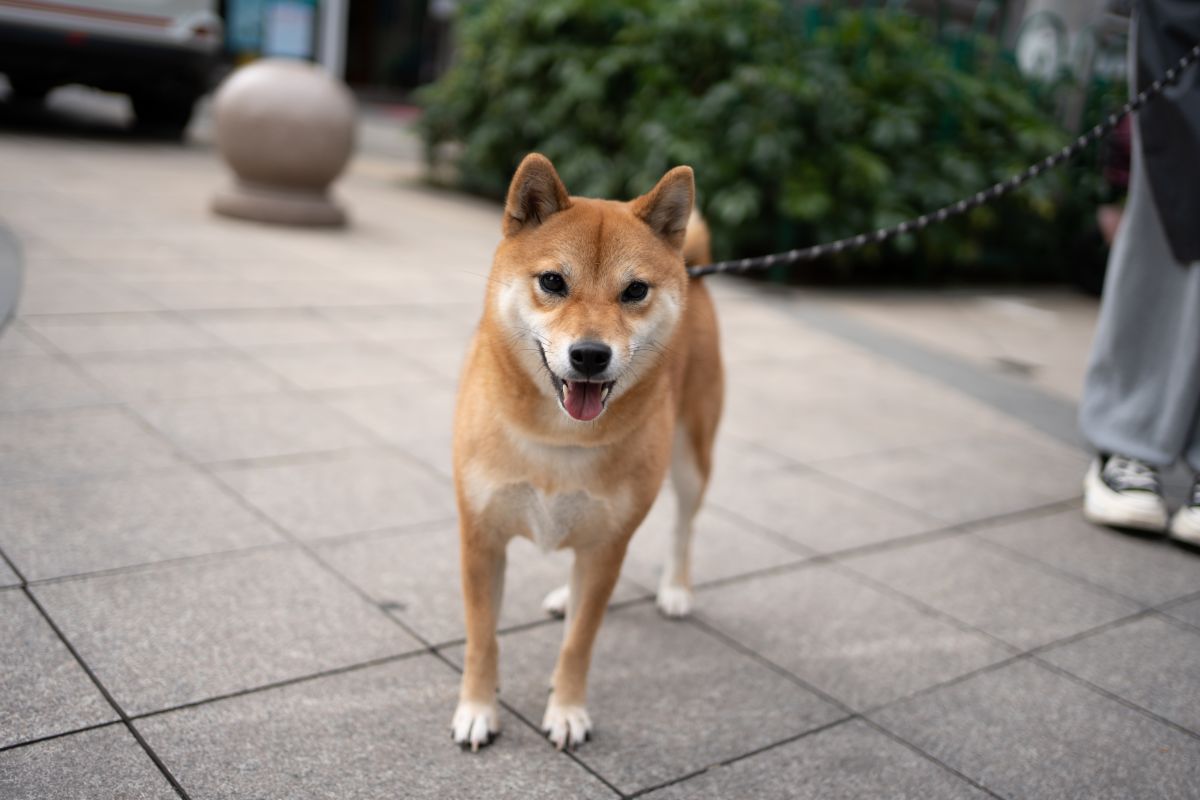
How To Encourage Good Behavior On Walks
On walks, dogs can become incredibly excited and stimulated by all of the things around them.
Certain scents, locations, people, animals, other dogs can make them lunge forward, pull on the leash, bark at other dogs, or react to stimuli.
Distraction
The most common problems dog owners will face is pulling and lunging on the leash. This is a self-rewarding behavior, where the dog thinks that if it pulls hard enough, it can go wherever it wants to go.
It is your responsibility as the owner to ensure that your dog knows that you are leading the walk, not them. You may have already practiced and taught your puppy to heel at home, but they can become easily distracted and start to pull on walks.
If your puppy does become excited, and starts to lunge forward, then the best thing to do is make yourself more interesting and more attractive to the dog rather than what is ahead of them.
To do this, you will need high value treats, meaning extra tasty, high protein ones.
This can help your dog focus on you again, and ignore the other object or animal that is stimulating them.
Stop
If your puppy is pulling a lot, then instead of yanking them back, stand still and stoic, like a tree. Do not move forward or go with them.
Stand still and strong, so that your puppy understands that they cannot pull you forward any more. They will have to come back to you.
When the puppy does return to your position, then you can reward either by giving treats, or by moving forward.
This can help them learn that they will only progress forward when you say so, not when they pull. If they walk nicely, then they will be able to go forth.
Redirection
You can also try and redirect the puppy towards you.
You can either do this with a leash that also clips onto the front of the harness and the back of the harness so you have full control, and can change their direction, or you can change direction by walking another way.
It is best to try redirecting your puppy as soon as you can anticipate that they will become distracted. It will be harder to do once your puppy is already distracted by something.
Heeling
Another method to maintain control when your puppy is lunging or pulling towards somewhere is to try recalling them and getting them to heel.
If this is not working, and your puppy is ignoring you, then you can try gently pulling on the leash to turn them into another direction.
Keep A Short, Loose Leash
Another popular method is to use a short leash. Now, this doesn’t mean that you should have the leash tightly wrapped around your hand.
The leash needs to be kept short, but loose so that your dog does not feel restricted or restrained as this can cause more anxiousness and leash reactivity.
Try using two hands on the leash to ensure control, keeping the end attached to your dog quite loose so that they do not feel stressed. This can also make sure that you have extra control.
Treats & Rewards
You can also hold a treat in front of your puppy’s nose so that you can lure them and coax them to walk along in a close-by position while you are on your walk, instead of allowing them to pull you ahead.
Preventing Barking On A Leash
As your puppy gets older, it is even more important to teach good manners when on a leash. Some dogs may bark at others when walking, or whine and cry when they see other dogs due to over-excitement.
Dogs may bark when on walks due to a lack of exercise and stimulation. They need mental and physical stimulation to keep them happy and healthy. This lack of stimulation can accumulate and make them very over excited.
In these cases, it is vital that you have treats on hand. Treats can help you redirect the dog’s focus onto you, and help you encourage them to behave better if they want to have the tasty treat!
What Not To Do When Training Your Puppy To Walk On A Leash
There are a few things that you will want to avoid doing when teaching your puppy to walk nicely on a leash. It can be frustrating if your puppy is adamant on dragging you forward, but you have to remain calm.
You should not yank or pull your dog, dragging them where you want to go. This can only create a more negative relationship with being on the leash.
Never yank or pull your puppy on a leash, especially if it is connected to their collar. This can damage and harm the neck muscles and bones, causing injury or pain.
When Do I Stop Taking Treats On Walks?
As you may have noticed, most of our training methods for walking well on a leash involve the use of treats as a reward.
Positive reinforcement means that something good happens, like receiving food when the dog does something that you want.
You may be wondering if you have to take treats with you on walks forever.
We do recommend that you always have treats, as this can help you get your dog back if they slip out of the lead or break their recall. They will more than likely come back if you have their favorite snacks with you!
But, you will not always have to take treats on walks. Eventually, you can reduce the number of treats given as your dog’s training improves.
After a while, you can just positively reinforce good behavior with spoken commands like ‘good’ and ‘yes’ or by giving your dog some affection.
Final Thoughts
To summarize, teaching your puppy to walk on a leash is easier than you may think! All you need to do is build up a positive relationship with your puppy and being on a leash.
As long as you practice beforehand in a safe, controlled environment such as your home or yard, and use positive reinforcement to encourage good behavior on walks, your dog will begin to enjoy their walks without any issues.
- How To Teach Your Puppy Their Name Easily! - July 18, 2023
- Is Your Puppy Counter Surfing? Find Out How To Stop It! - July 18, 2023
- How To Train Your Puppy For Car Rides: Everything You Need To Know - July 18, 2023



